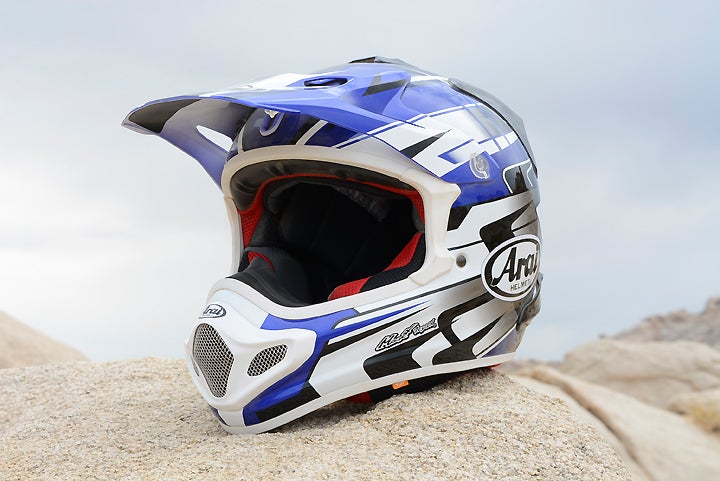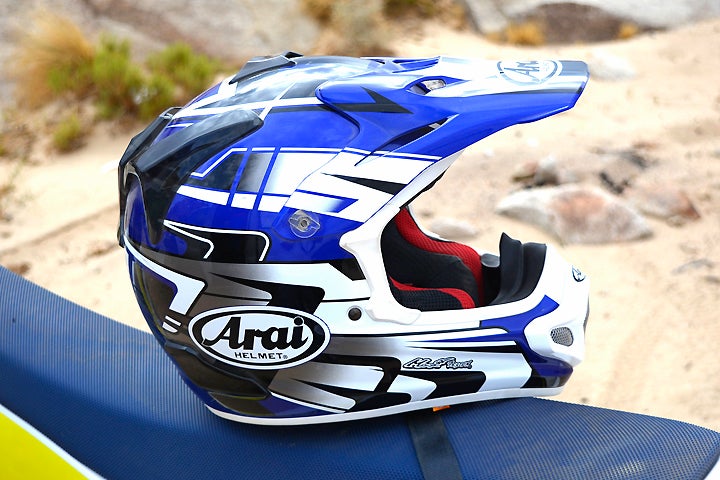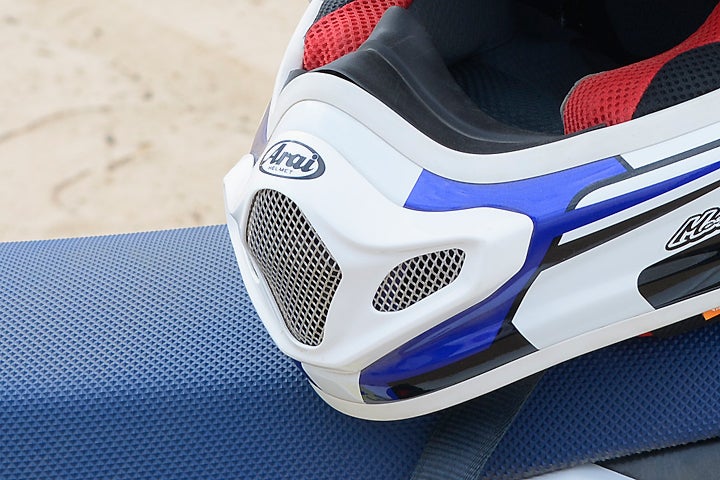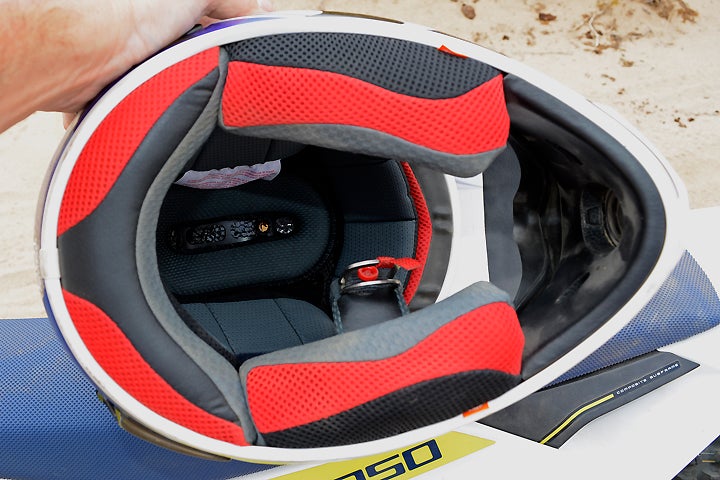
Arai is hoping that its customers will never have to find out just how good its motorcycle helmets are, but just the same it builds every one of its VX-Pro4 off-road helmets to exacting standards in an effort to make it the safest helmet on the market.
For motocross and off-road riders, the Arai VX-Pro4 is currently the top of the line, and it not only features all of the Japanese company’s latest safety innovations, it’s also the best-ventilated full-face helmet the company has manufactured in its 60+-year history.
Designed to meet or exceed SNELL and DOT standards, the VX-Pro4 is based on Arai’s R75 hand-molded shell, which gets its name by following Arai’s vision of the perfect shell shape, featuring a radius of 75mm. According to the company, that makes the shell as round as possible to better disperse impact energy.
Every VX-Pro4 starts with a handmade shell consisting of Arai’s proprietary Super Fiber. It’s an expensive material that costs of up to six times more than standard fiberglass, but Arai selected Super Fiber for its superior strength and elasticity properties, tensile strength and penetration resistance. The shell is constructed using Arai’s cLc (complex Laminate construction) method, a time-consuming process in which Arai’s master craftsmen build each shell from many individual pieces.

The VX-Pro4’s ventilation system begins here, with the careful cutting of the of its Air-Through top front, top rear and side port ducts. In addition to increasing air flow through the VX-Pro4. Arai also made the new ducts easier to clean and maintain. The helmet’s top rear duct diffusers can be easily removed or replaced simply by removing a single screw on the rear duct brace.
Arai’s goal of ultimate head protection obviously extends to the inside of the VX-Pro4 as well. The company’s proprietary EPS liner is made up of multiple cells of different densities within the same one-piece liner to disperse impact energy that passes through the shell. The EPS liner is designed so that each cell is a sort of helper to the cells around it. As one EPS cell is crushed under impact, the surrounding cells also absorb some of that energy.
The lower front portion of the VX-Pro4 is designed to be as compact. The chin bar is designed to be as tucked in as much as possible in order to maintain Arai’s radius standards for the entire envelope. Other off-road helmets may feel less claustrophobic once they’re on the wearer’s head, but Arai counters that by saying that the VX-Pro4’s chin bar is less likely to be snagged by debris or other impediments during a crash. Arai did attempt to mitigate the closeness issue by incorporating a much freer-flowing chin bar vent grill in the VX-Pro4 than the one found in its predecessor, the VX-Pro3. The VX-Pro4 grill mounts to the outside and is easily removable for cleaning or damage replacement. The grill is also designed to break away in the event of an impact, reducing the likelihood that it will pass impact energy to the wearer’s head.

Ditto for the VX-Pro4’s visor, which is 14mm longer and 5mm wider than its predecessor to improve debris and roost deflection. Because of the visor’s length and width, large air outlets are incorporated to help reduce lift and buffeting at high speeds.
We’ve been wearing and living with the Tip Blue Arai VX-Pro4 that you see in the photos for a considerable length of time now, and it is our go-to helmet when not wearing helmets that are branded with the riding gear that we are wearing. All of the VX-Pro4’s safety features are a strong reason for that, but it’s the excellent comfort level of the VX-Pro4’s interior that keeps us coming back to the lid. The interior consists of Arai’s MotoGP-developed Dry-Cool liner and cheek pads, which Arai’s triple-density foam construction. The Dry-Cool liner fabric is enhanced by micro water cells that are designed to improve moisture and heat transfer from the head into the airflow of the ventilation system to reduce sweat and moisture in the helmet’s interior. The fabric is also designed to dry much quicker than other fabrics. And when the liner does get too funky, it’s nice to be able to pop it out of the VX-Pro4 and drop it in the washing machine to freshen it up. The VS-Pro4’s neckroll is also removable for cleaning.
Part of the Arai’s comfortable fit is due to the its Facial Contour System, which incorporates a foam spring support in the cheek pad to keep the helmet snug to the rider’s face yet compresses and rebounds during installation or removal of the helmet on the head. In another important nod to safety, the VX-Pro4 features an emergency cheek pad release system to facilitate a safe removal of the helmet to minimize the possible aggravation of a neck injury. The cheek pad tabs are easy to access by emergency staff.
But what we’ve noticed most is that the VX-Pro4 delivers on its promise of being cool and comfortable even in extremely hot-weather riding such as what we encounter while testing in Southern California’s Johnson Valley OHV area during summer months. The 100+-degree temperatures are enough to cook the brain of almost anyone wearing a helmet in them, but the VX-Pro4’s comfort and ventilation make riding in the heat tolerable despite the closeness of its chin bar.

Our complaints about the VX-Pro4 are minimal, but while the VX-Pro4’s forward air ducts can be opened or closed to manage the air flow coming into the helmet, we liked the fact that previous VX-Pro3 also featured tabs that allowed the wearer to manage the the top and rear ports individually in the shell. That’s a nice option to have in cooler weather but not one found on the VX-Pro4.
Cost is a huge factor when purchasing any piece of riding gear, and the Arai VX-Pro4 is an expensive helmet. Arai has never made apologies for that, holding the line that it makes the safest helmet on the market and its extensive R&D and material choices cost money. We suspect the company may have originated the “If you have a five-dollar head” statement that is used to justify the cost of a high-priced helmet. What we do know for sure is that $599.95-$739.95 is a lot of money to spend on a helmet whether it is worth it or not, so our suggestion is that if you think the VX-Pro4 is for you, shop around and look for deals. Many of the online/mail-order houses offer the VX-Pro4 for substantially less—we’ve seen VX-Pro4s advertised for as low as $539.95 in solid colors such as Black Frost and White and for nearly $100 less than MSRP for one of Arai’s snazzy mutli-color VX-Pro4s. If you’re really on a budget, we suggest looking around for a new VX-Pro3. Several outlets are still offering them on closeout. Although size and color choices may be limited, we’ve seen new VX-Pro3s in the $300-400 range.
But in our opinion, ponying up for an Arai VX-Pro4 is money well spent. Knowing that it represents Arai’s decades of uncompromising safety innovation is good for peace of mind, but it’s the VX-Pro4’s extreme comfort that makes us such fans of this helmet.
The Arai VX-Pro4 is available in sizes XS-XXL, and in numerous color choices. For more information on the Arai VX-Pro4, visit AraiAmericas.com.
Arai VX-Pro4
MSRP: $599.95 (White or Black Frost)
MSRP $739.95 (Barcia Black, Barcia Orange, Barcia Green Frost, Nutech, Sly Yellow, Tip Blue, Tip Green, Tip Orange, Tip Red, Tip Yellow/Blue, Dazzle Red, Dazzle Blue, Dazzle Orange, Dazzle Dirt, Dazzle Neon, Tickle Trophy-Girl Red, Tickle Trophy-Girl Blue, Tickle Trophy-Girl Green)
Arai Helmet, Inc.
P.O. Box 787
Fogelsville, PA 18051-0787
Phone: 610-366-7220 (Monday-Friday 9am-5pm EST)
Fax: 610-366-7221
Email: info@araiamericas.com
Website: www.araiamericas.com
 Your Privacy Choices
Your Privacy Choices